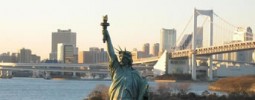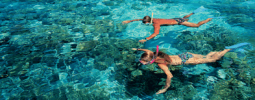Siem Reap is the capital of the Siem Reap Province in Cambodia. It’s the most popular tourist destination after Phnom Penh and has a large number of hotels and restaurants and perhaps better known as Angkor Wat. The city has a population of about 150 thousand citizens as of latest measurement.
The city of Siem Reap is filled cultural, ancient and historical temples, tombs and buildings with Chinese-styled architecture. Two famous area’s within Siem Reap are the Old French Quarter and Old Market. In town the narrow and sandy streets are filled with craft shops, silk farms, rice-addy countryside, fishing villages and a bird sanctuary near Tonle Sap Lake. Traditional Apsara is being performed in public outside bar areas. Several popular tourist sightseeing include the Cambodia Landmine Museum, Angkor National Museum, Angkor Thom, Psar Chaa and the Central Market which is a one of a kind market.
As the tourist numbers increased over the years, a lot of new hotels, guest house and restaurants have settled in the area. Most of the guest houses are concentrated around the old market area, while the expensive and international hotels are situated between the Siem Reap-Angkor International Airport and along the highway of National Road 6. For those travelers who are looking for the best price / comfort class are recommended to go the variety mid-range hotels and restaurants along Sivatha.
Travelers to Siem Reap require a valid passport and visa. American citizens will receive a visa upon arrival valid for 30 days in exchange for $20.00 US. There’s also an exit fee of $25.00 US when leaving the country. Petty theft and crimes are not uncommon in the city, the overall crime rates are rather low. Always make sure to look after your belongings.
Banlung is a small town in the north east of Cambodia. It is the capital of Ratanakiri Province. The city has a population of 17 thousand people, but it is still growing. Its surroundings are heavily forested. The city is an important commercial center. Many people from neighboring villages sell their goods on the market of Banlung.
Banlung itself isn’t very spectacular. The town is growing however and many roads are being built. In the center there are two story buildings, a monument, a market and a few newly paved roads. Banlung is however a very good base to visit the undiscovered parts of the Ratanakiri Province. This province is heavily forested. People are active in plantation agriculture, for rubber, cashews and oil palms. There are also gem mines.
The surroundings of Banlung offer several spectacular natural attractions, including waterfalls, lakes and natural parks. Worth a visit is the 700 thousand year old Yeak Laom Volcanic Lake, 3 miles from the town centre. Spectacular waterfalls are Cha Ong, Kan Chang and Ka Tieng. You will come across rubber plantations on your way up. Active possibilities are rafting, kayaking and dirt bike rides.
Travelers to Banlung require a valid passport and visa. American citizens will receive a visa upon arrival valid for 30 days in exchange for $20.00 US. There’s also an exit fee of $25.00 US when leaving the country. Banlung and its environment is home to 12 ethnic groups. Respect their culture and remember that many taboos exist.
Sihanoukville is a port city in the south of Cambodia and overlooks the Gulf of Thailand. The city is named after King Father Sihanouk, but it also known as Kompong Som. Sihanoukville suffered from war and it was the place of the last official battle in the Vietnam War. These days the city attracts tourists with its fine beaches and laid back atmosphere. The city also attracts foreign and national investors. It has a population of some 18 thousand people.
Sihanoukville was founded in 1960 after Cambodia became independent from France. French-Cambodian people carved a camp out of the jungle in 1955. They began building the first, and only, deep-sea port in order to communicate with international trade. During the Vietnam War the port was used by the Vietcong and later by the American army. The last ten years the city has been picking up the pieces. The Independence Hotel is up and running again and more and more Khmer people are running bars and restaurants.
Sihanoukville has some good beaches for relaxation. The popular beaches are Ochheuteal, Sokha, Otres, Independence and Victory Beach. Some beaches have there own beach resorts. There are more than a dozen islands to hop around. You can take water taxis to go scuba diving, snorkeling and swimming. Be aware that the beaches can be covered in more rubbish than you might be used to. There are businesses that tried to dump their waste into the city.
Travelers to Sihanoukville require a valid passport and visa. American citizens will receive a visa upon arrival valid for 30 days in exchange for $20.00 US. There’s also an exit fee of $25.00 US when leaving the country.
Phnom Penh is the capital, wealthiest and the largest city of the Kingdom of Cambodia. Its located at the confluence of the Mekong and the Tonle Sap rivers. The capital city of Cambodia has a population of one million people. Phnom Penh is a great introduction to Cambodia since its almost as dirty, dusty and chaotic as the rest of the country.
Travelers to Phnom Penh / Cambodia must understand, even for those who visited other Asian countries that there will be a culture shock. Forget about convenient stores, 7-11′s or a supermarket near your guest house. Once arrived in at the airport, a taxi ride in town with the airport taxi service will cost you $9 US. Since large or international hotel chains are rare it’s most convenient staying at a guesthouse. Cambodia does not seem to have many laws, for example it’s local gun range where tourists can fire a large variety of guns isn’t further than a few minutes from the Phnom Penh International Airport landing strip.
Transportation within the city is widely available. Choose to travel by motorbike, rickshaw, tuk tuk or a regular car taxi. It’s recommended to hire a taxi driver by the day rather than per individual ride. Cambodian people are referred to as Khmer. Khmer people love to be outside therefore the city has several spacious parks and markets, one of the most famous parks is Wat Phnom referred by tourists as “monkey park” where, as you can guess monkey walk freely in city center. There’s also a boulevard which goes along the Mekong river with several small restaurants and bars where both local Khmer & European food can be ordered. A specialty being served here is Marijuana Pizza which can be ordered in three “sizes” named, happy, super happy and super super happy pizza.
For travelers that enjoy cultural and spiritual Phnom Penh offers several museums, for example the National Museum of Cambodia, which is the country’s leading historical and archaeological museum. The museums houses the world’s largest collection of Khmer art, including ceramic, bronzes, sculpture and ethnograhpic objects. In total the museum’s collection is greater than 14 thousand items, from prehistoric times and periods before, during and after the Khmer Empire, swhich was strechted from Thailand, across today’s Cambodia, until southern Vietnam.
Travelers to Phnom Penh need a valid passport and visa. American Citizens will receive a visa upon arrival valid for 30 days in exchange for $20.00 US. There’s also an exit fee of $25.00 US when leaving the country. As petty theft and crime are common.
The small town Sisophon is located in the northwest of Cambodia. It is the capital city of Banteay Meanchy. The town is officially named Serei Saophoan, which is generally transliterated as Sisophon. The name Serei Saophoan is Khmer for “beautiful lady”. The area used to be inside Thailand before the French gave it back to Cambodia. Sisophon is strategically situated at the intersection of National Highway 5 en National Highway 6.
Sisophon makes a good first stop when traveling from Poipet in the west. It is also a good place to start exploring some sights around. It is about fourty minutes to get to the Khmer temple of Banteay Chmar, to the north of the town. You can also visit the Angkorian temple of Banteay Top. More to the northeast there is a special bird sanctuary, called Ang Trapeng Thmor Reserve.
Sisophon is connected to many other cities in Cambodia through the National Highways. Traveling from the town to other cities is easy, but be aware of the state of the roads. Highway 69 for instance to Banteay Chmar is impassable during raining seasons. Battabamg to the south, Poipet to the west and Siem Reap to the east are more accessible by driving on Highway 5 or Highway 6.
Travelers to Sisophon and Cambodia require a valid passport and visa. American citizens will receive a visa upon arrival valid for 30 days in exchange for $20.00 US. There’s also an exit fee of $25.00 US when leaving the country.








